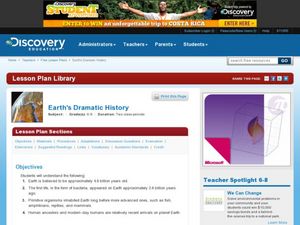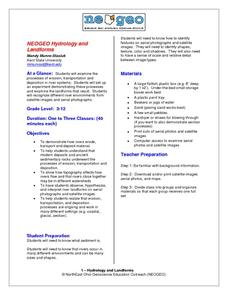Space Awareness
History of the Universe
Your pupils may believe that you and their parents are the oldest things in the universe, but surprise! There are elements of the universe that are even older. Elementary scientists create a class timeline to demonstrate the...
Curated OER
Sun and Shadows
Why do shadows look different in the summer than in the winter? What causes day and night? How can a sundial be used to tell time? Answer these questions and more through two engaging lessons about light and shadows. Fourth and fifth...
Big Kid Science
Measuring Shadows Using an Ancient Method
How did ancient peoples determine the height of really tall objects? Young scientists and mathematicians explore the concept of using shadows to measure height in a hands-on experiment. Paired pupils measure shadows, then calculate the...
Curated OER
The Earth Day Groceries Project
Students research Earth Day and make bags to hand out on Earth Day to help promote taking care of the environment.
Curated OER
Modern Day Pyramids
Learners investigate the ways in which ancient technologies - six types of simple machines and combinations - are used to construct modern buildings. As they work together to solve a design problem (designing and building a modern...
Curated OER
Space Day Activities
Celebrate Space Day on May 7th with aerospace lessons that are sure to get kids excited about science and engineering!
Curated OER
Earth's Dramatic History
Learners create a timeline. In this Earth's History lesson, students research the history of life on Earth and use the information collected to create a timeline. Learners also answers the provided discussion questions.
Ventura County Air Pollution Control District
Effects of Global Warming
Your learners have probably heard of climate change, but do they really understand what it is? Study the history, details, and future implications of global warming and the greenhouse effect with a set of activities designed for an...
Curated OER
Science Puzzlers, Twisters, and Teasers: The History of Life on Earth
A somewhat amusing assignment, this worksheet lists statements that an ancient organism may have made and asks learners to determine what geologic era that each may have lived in. It uses witty word puzzles and fill-in-the-blank-style...
Curated OER
Out and About: The History of Medicine
Young scholars investigate the history of medicine. In this medicine instructional activity, students may visit the Thackray Medical Museum, the Old Operating Theatre, or the Edward Jenner Museum in Britain online or in-person to...
Curated OER
Kirigami: The Ancient Art of Paper Cutting
Young scholars perform inquiry into the ancient art of Kirigami. The research provides a context for the activity and how it is related to History. Students also appreciate the art for the sake of its contribution to culture.
Curated OER
Earth Day Lessons With The Right Stuff
Earth Day lessons provide a great way to teach students about the significance of the event, and how they can make a difference.
Curated OER
Fossil Fuels (Part II), The Geology of Oil
More of a mini-unit than a lesson plan, these activities lead inquisitors through a survey of oil deposits. In the first part, they read about and view diagrams of sedimentary rock layers that trap oil. Next, they test porosity and...
Curated OER
Fossil Fuels (Part II), The Geology of Oil: Topographic Mapping, Crustal Deformation, Rock Porosity, and Environmental Pollution
Students review an interpretation of geologic history and relate it to the formation of oil deposits. They explore and explain factors controlling the porosity and permeability of sediments and sedimentary rocks. Pupils also interpret...
Curated OER
Middle and Recent Earth History
In this middle and recent Earth history worksheet, learners are given 20 statements about the changes in the Earth and life on Earth and they determine if they are true or false. If the statements are false, students change the...
Curated OER
Celebrating Our Connections Through Water
Learners examine the role of water in ceremonies around the world. In this world history instructional activity, students explore how other cultures celebrate water. They create a Water Day for younger learners to participate in.
Virginia Department of Education
DNA Structure, Nucleic Acids, and Proteins
What is in that double helix? Explain intricate concepts with a variety of creative activities in a instructional activity that incorporates multiple steps to cover DNA structure, nucleic acids, and proteins. Pupils explore the history...
NorthEast Ohio Geoscience Education Outreach
Hydrology and Landforms
Three days of erosion exploration await your elementary geologists. Learners begin by examining rivers via Google Earth, then they model water flow in sand, and finally, they identify resulting landforms. This lesson is written...
Curated OER
Dark Days
Fifth graders explore U.S. history by viewing video clips in class. In this dust bowl era lesson, 5th graders identify the impact of giant dust storms on the U.S. agriculture systems and the U.S. economy in the 20th century. Students...
Curated OER
Albert Einstein
In this online interactive history quiz worksheet, students respond to 50 multiple choice questions about Albert Einstein. Students may submit their answers to be scored.
Curated OER
Werner Heisenberg
In this online interactive history quiz learning exercise, students respond to 50 multiple choice questions about the accomplishments of Werner Heisenberg. Students may submit their answers to be scored.
Curated OER
Isaac Newton
For this online interactive history quiz worksheet, students respond to 49 multiple choice questions about Isaac Newton. Students may submit their answers to be scored.
Curated OER
Max Planck
In this online interactive history quiz worksheet, students respond to 49 multiple choice questions about the accomplishments of Max Planck. Students may submit their answers to be scored.
Curated OER
Here's To Your Healthy Heart!
Students examine the primary controllable and uncontrollable factors that put one at greater risk for developing heart disease. Through discussion, research, physical tests, and questionnaires they determine whether or not they are at...























